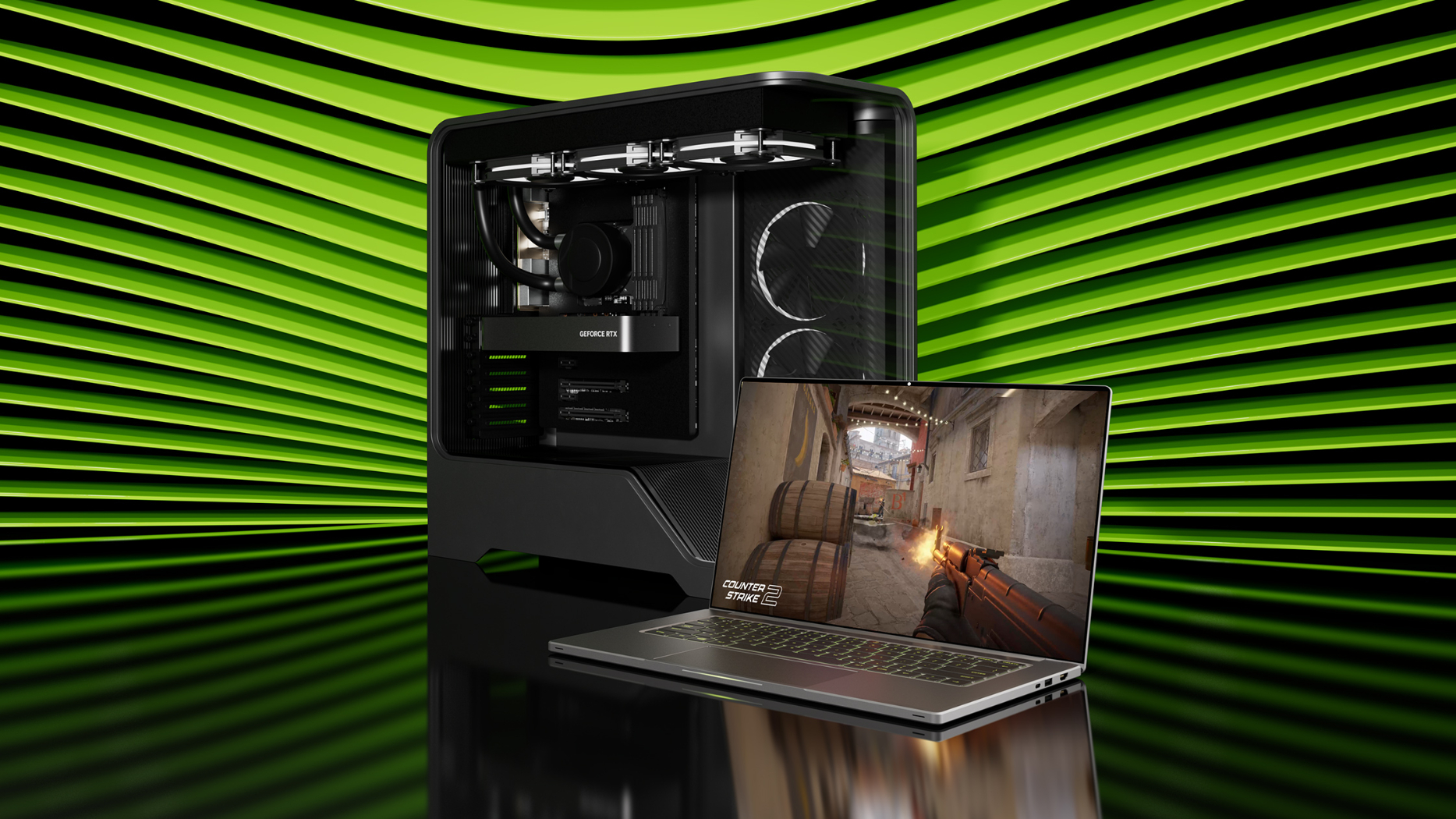Nvidia explains why its desktop RTX 5050 only uses GDDR6 memory instead of GDDR7 like the laptop version — 'G6 is the best choice for desktops and the more power efficient G7 is the best choice for laptops'

Nvidia's decision to use older GDDR6 memory with its RTX 5050 desktop GPU has taken some by surprise, given that its laptop counterpart features newer and faster GDDR7 memory. Nvidia's director of global PR, Ben Berraondo, responded to Hardware Cannuck's on X, defending Nvidia's usage of GDDR6 in the RTX 5050 desktop card, claiming GDDR7 is the "...best choice for laptops."
Bernado says that the RTX 5050 series presents a special case where GDDR6 is more beneficial on the desktop version, and GDDR7 is more beneficial on the laptop version, rather than having both powered by GDDR7. He explained that the memory type's lower thermals and greater power efficiency are why the mobile RTX 5050 features GDDR7, while the desktop version does not.
The RTX 5050 notebook GPU has been optimized for the best power efficiency for portable laptops with great battery life. Therefore G6 is the best choice for desktops and the more power efficient G7 is the best choice for laptops.June 25, 2025
In this case benefits of G7 are for thermals and battery life, crucial for our OEM partners and hopefully you’ll see some great laptop optionsJune 25, 2025
For those not up to speed, the desktop and laptop variants of the RTX 5050 feature largely identical hardware specifications, featuring 2,560 CUDA cores, 8GB of memory capacity, and a 128-bit memory interface. Where they differ is in the use of different generation GDDR memory, clock speeds, and power targets.
Berraondo neglected to share any advantages GDDR6 offers to the desktop version of the RTX 5050 (if any). Only mentioning that "...G6 is the best choice for desktops". GDDR6 has no apparent advantage over GDDR7 in terms of raw specs, so it would be interesting to hear more of Berraondo's thoughts on the matter. It's fair to assume that cost would also weigh into this decision.
There is no reason for Nvidia to use GDDR6 from a pure performance perspective. GDDR7 is not only more thermally and electrically efficient (allegedly) but also provides significantly more bandwidth than the fastest GDDR6 modules. The fastest GDDR6 speed bins currently available on the market are rated at 20 Gbps. GDDR7 provides 40% more bandwidth than GDDR6, with the slowest modules operating at 28Gbps. (The RTX 5080's GDDR7 is even faster, running at 30Gbps.)
It is likely Nvidia chose GDDR6 on the desktop RTX 5050 for cost-saving reasons and possibly better supply chain availability. Nvidia uses GDDR7 on all of its other RTX 50 series GPUs, including the high-in-demand RTX 5090. Using GDDR6 on the RTX 5050 desktop GPU allows Nvidia to prioritize its GDDR7 supply to higher-end GPUs, assuming GDDR7 supply chains are strained.
There is also a chance that Nvidia did not need to use GDDR7 on the desktop RTX 5050, regardless of availability or pricing. The GPU has so few CUDA cores (only 2,560 cores) that it might be compute-limited with GDDR7.
Get Tom's Hardware's best news and in-depth reviews, straight to your inbox.
Regardless, for unknown reasons, Nvidia has opted to use GDDR6 for the desktop version. The desktop RTX 5050 arrives later next month, starting at $249.
Follow Tom's Hardware on Google News to get our up-to-date news, analysis, and reviews in your feeds. Make sure to click the Follow button.

Aaron Klotz is a contributing writer for Tom’s Hardware, covering news related to computer hardware such as CPUs, and graphics cards.
-
RedBear87 A nice idea for an article would be "Nvidia defends the indefensible", recapitulating some of the most arguable choices they made in the last few years and how they justified them publicly.Reply
If they really wanted to go with GDDR6, I would have liked this better if they had used a 192bit interface with 12GB VRAM, like the old 3060, but I guess that would have risked to really show why the 5060 8GB is so terrible. -
Notton https://www.nvidia.com/content/dam/en-zz/Solutions/geforce/news/rtx-5050-desktop-gpu-and-laptops/geforce-rtx-5050-desktop-gpu-performance.pnghttps://www.nvidia.com/content/dam/en-zz/Solutions/geforce/news/rtx-5050-desktop-gpu-and-laptops/geforce-rtx-5050-laptop-gpu-performance.pngThere's no benefit to using GDDR6 over GDDR7 on a desktop card.Reply
The laptop 5050 uses GDDR7 24Gbps.
There is a significant power limit on the laptop version. Laptop has 80W vs. the desktop's 130W maximum.
Looking at the numbers nvidia posted, IDK if 50W is enough to explain the performance difference between the desktop and laptop version.
So I'm going to assume nvidia used GDDR6 on the desktop 5050 as a cost cutting measure and pocketed the savings.
Also, I totally expect nvidia to pull nvidia shenanigans and offer a desktop 6GB GDDR7 version, a laptop GDDR6 version, and maybe even a laptop 4GB version with no labels to indicate they're different from the 8GB version.
If they decide to offer a 12GB (96-bit) version, it'll be called the 5050Ti. -
usertests Reply
They are using an even smaller GB207 die in this. 5060 uses GB206. Fat chance of 192-bit. 12 GB or 9 GB on 96-bit would be pretty funny though.RedBear87 said:A nice idea for an article would be "Nvidia defends the indefensible", recapitulating some of the most arguable choices they made in the last few years and how they justified them publicly.
If they really wanted to go with GDDR6, I would have liked this better if they had used a 192bit interface with 12GB VRAM, like the old 3060, but I guess that would have risked to really show why the 5060 8GB is so terrible.
In fact, the 9 GB isn't so unlikely since GDDR7 could balance out the smaller memory bus, and from laptop we can see it's designed to use either GDDR6 or GDDR7. Wow.
There is nothing wrong with what they did to cut costs in the 5050. Only the price is wrong: it should be $200 MSRP instead of $250. -
beyondlogic its a joke and cost cutting that gddr6 is used cant use the efficiency excuse cause they could have let gigabyte put a connector on the end like with the 4060 mini they did. the card needs to be under 250 usd more 180 usd.Reply -
usertests Reply
5060 is 20% more at $300 for +50% CUDA cores, but probably less perf gain. Hardware Unboxed guessed +30%.beyondlogic said:the card needs to be under 250 usd more 180 usd.
So this card would have better price/perf at $200, and maybe as high as $225. No need to go to $180, or unrealistic demands like $150. The $250 MSRP is awful though.
The more pressing concern is getting a 12 GB version of the 5060. -
Jabberwocky79 "GDDR6 is better for the desktop version *for us"Reply
Nvidia - The way you're meant to be played. :sneaky: -
edzieba If the chip is not memory bandwidth limited, then GDDR6 is a pure cost saving with no performance penalty in actual applications (rather than memory bandwidth benchmarks). Why GDDR7 for mobile? Power savings, and takes less of the limited thermal budget that can then be used by the CPU die, which will be slower than a non-thermally-limited desktop 5050 anyway.Reply -
Amdlova Nvidia it's only thinking in get tons of gddr6 to keep Amd memory starvation high.Reply
A simple 5050 will eat a big market share from Amd. And will push the Amd products to higher price, making it less attractive...
The worse nvidia product can literally destroy the entire Amd market. -
George³ Does anyone have any memories of such a low-end class graphics card which wasting so much electricity?Reply